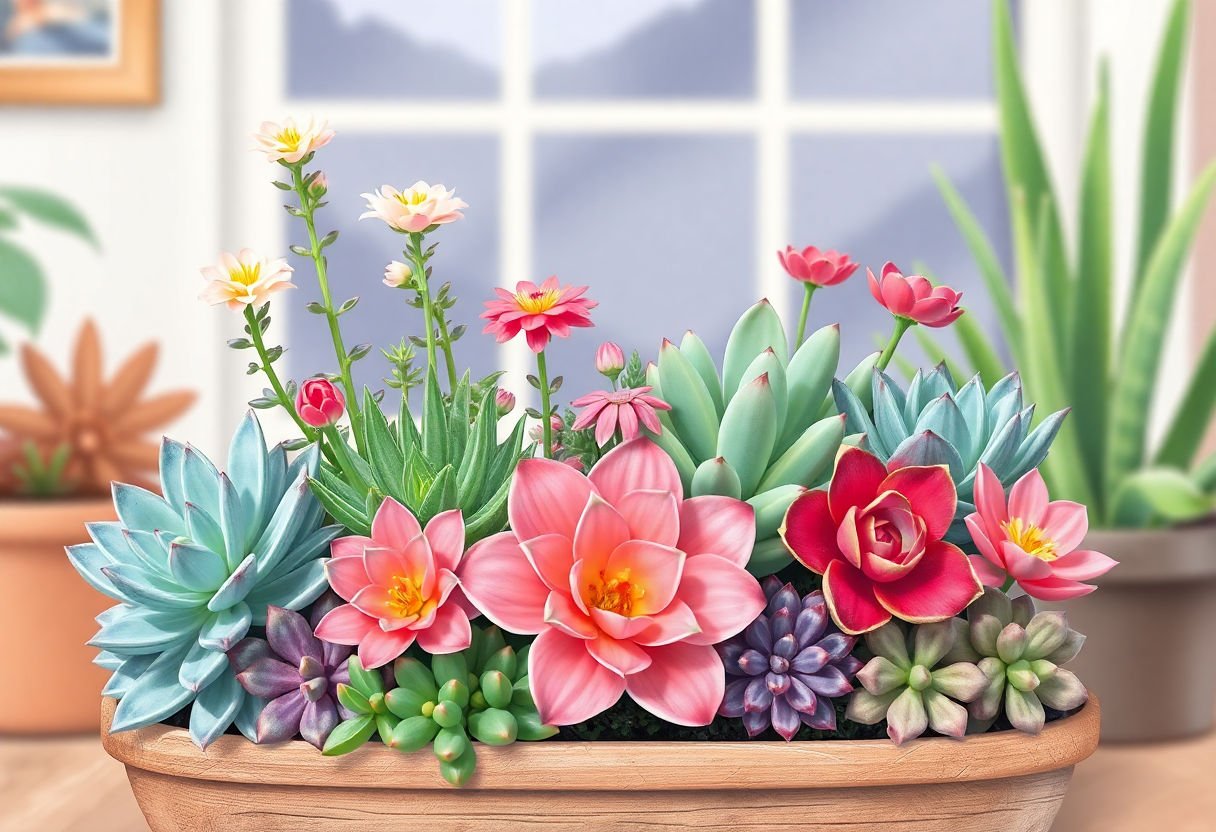Flowering succulents have become a captivating trend in home decor due to their unique appeal and versatility. These remarkable plants offer endless creative possibilities, from indoor terrariums and vertical gardens to stylish containers and hanging displays. Ideal for those seeking beauty with minimal care, their diverse display options make them a perfect choice for any setting. As you explore this guide, discover how these stunning succulents can enhance your living spaces and provide both aesthetic and health benefits. Embrace the elegance and simplicity of flowering succulents to transform your home environment.
Key Takeaways
- Flowering succulents offer a unique blend of beauty and low-maintenance care, making them ideal for home decor.
- These versatile plants can be displayed in numerous creative settings, from vertical gardens to terrariums.
- Selecting the right container enhances the aesthetic appeal and health of the succulent displays.
- Proper maintenance, including watering and lighting, is essential for sustaining the vibrant appearance of flowering succulents.
- Incorporating succulents can contribute to improved indoor air quality and overall home ambiance.
Understanding Flowering Succulents
Flowering succulents are a diverse and captivating group of plants, celebrated for both their stunning appearance and uncommon ability to thrive in various indoor environments. These striking plants combine the hardy nature of succulents with the exquisite beauty of flowers, making them an exceptional choice for home decor.
Types of Flowering Succulents
Flowering succulents encompass a variety of species, each with its distinct charm. Popular among these are the Kalanchoe, known for its vibrant clusters of small blooms, and the Echeveria, prized for its rosette shape and delicate flowers. Other notable types include the Haworthia, Lithops, and the Jade Plant, each offering unique floral displays that enhance their visual appeal.
Care Requirements
Cultivating flowering succulents indoors necessitates understanding their specific care needs to ensure robust growth and prolific blooming. These plants generally require:
- Bright, indirect sunlight to encourage flowering. Position them near windows that receive a few hours of morning or late afternoon sun.
- Well-draining soil to prevent root rot, a common issue among potted succulents.
- Minimal watering, allowing the soil to dry out completely between waterings. They are drought-tolerant and too much moisture can be detrimental.
- Occasional feeding with a balanced, water-soluble fertilizer during the growing season to promote healthy blooms.
Flowering succulents are resilient yet distinct, and understanding their needs allows you to appreciate their both ornamental and low-maintenance qualities. Their ability to flourish with minimal care while adding a touch of nature’s elegance to your living space exemplifies why they are a beloved choice for indoor plant enthusiasts.
The Benefits of Incorporating Succulents in Home Decor
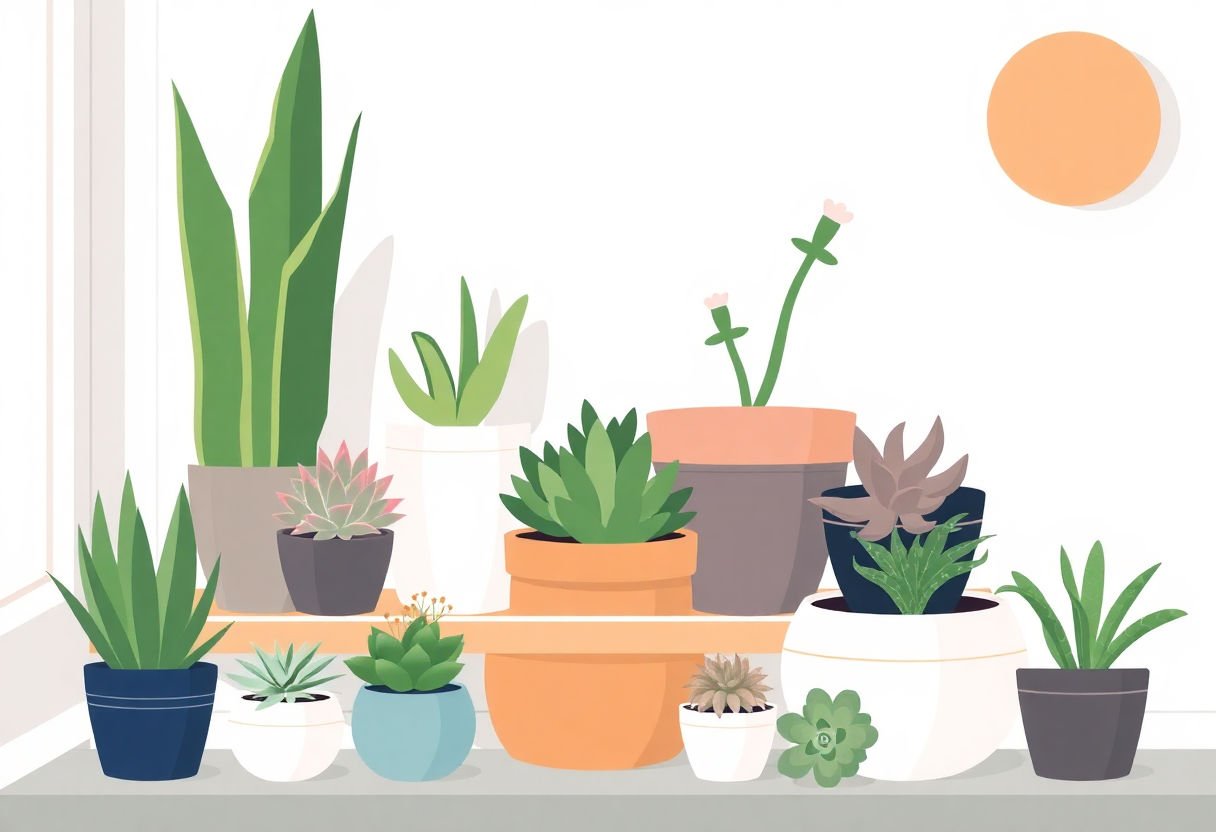
Incorporating flowering succulents into home decor offers an array of benefits that extend beyond aesthetic appeal. Succulents are celebrated for their striking visual impact, with their vibrant blossoms and sculptural forms enhancing any interior space. These hardy plants introduce an element of natural beauty that blends seamlessly with various decor styles, from minimalist to eclectic.
Aesthetic Enhancements:
- Flowering succulents come in a multitude of colors, shapes, and sizes, allowing for creative expression and personalization in home design.
- Their compact nature makes them ideal for integrating into tight spaces such as shelves, windowsills, and small nooks.
- As a dynamic design element, succulents can be used to add texture and dimension to any room.
Health Benefits:
- Succulents contribute to improved indoor air quality by absorbing toxins and releasing oxygen, promoting a healthier living environment.
- Their low-maintenance nature makes them a practical choice for individuals seeking the benefits of houseplants without demanding upkeep.
Stress Reduction and Well-being:
- Engaging with nature, even indirectly through houseplants, can lower stress levels and enhance mental well-being.
- The presence of greenery indoors has been linked to increased concentration and productivity, creating an optimal environment for work or study.
Choosing to decorate with flowering succulents not only elevates the visual appeal of a home but also fosters a sense of tranquility and wellness. By integrating these robust and versatile plants into your decor, you invite a harmonious balance between nature and modern living.
Choosing the Right Containers
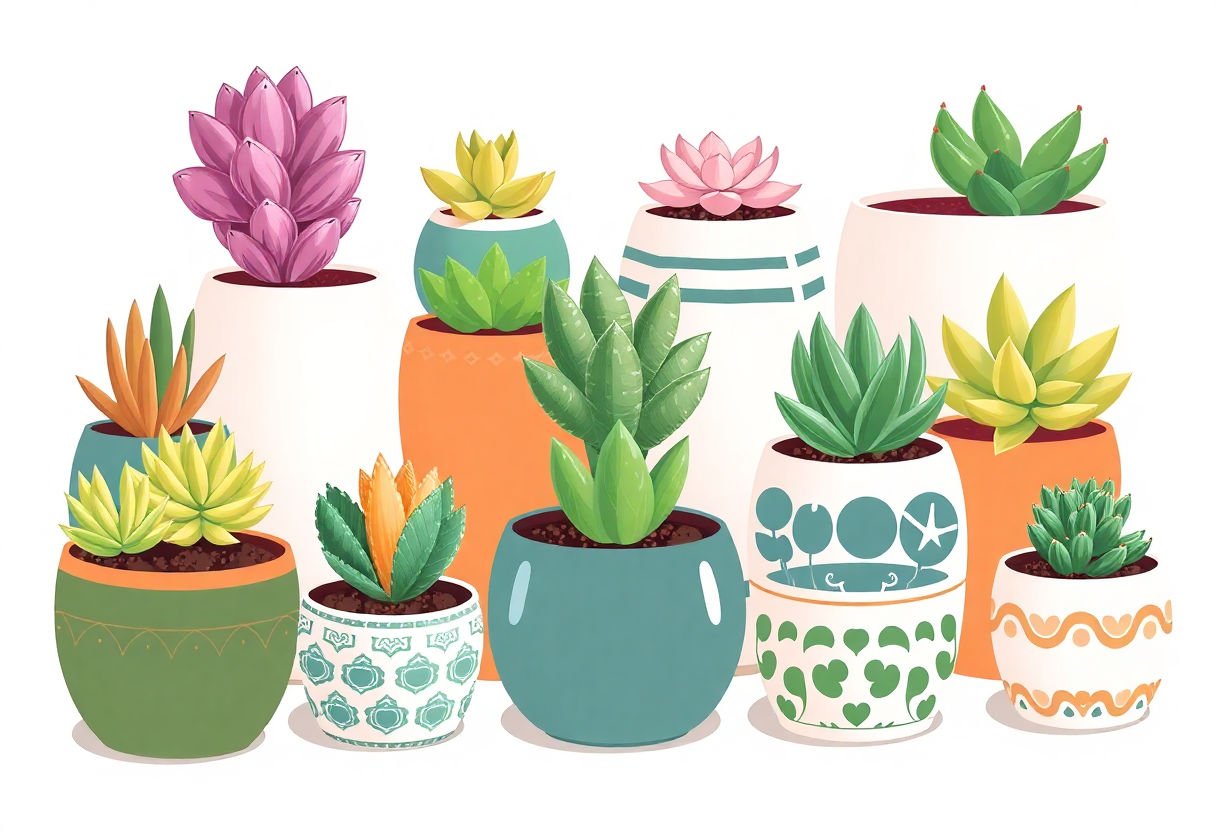
Selecting the right containers for flowering succulents is pivotal in enhancing both their aesthetic appeal and vitality. These remarkable plants thrive in environments that mirror their natural habitat, emphasizing the importance of choosing containers that offer both functionality and style.
When assessing container options, consider the material as it can affect moisture retention. Terracotta pots are a popular choice due to their porous nature, which allows for better drainage—an essential feature for succulents. On the other hand, glazed ceramic pots can retain more moisture, making them ideal for drier climates where succulents might require more hydration.
Size is another crucial factor. The container should be slightly larger than the root ball of the succulent, ensuring sufficient room for growth without surplus soil that can increase the risk of overwatering. Additionally, containers with drainage holes are imperative to prevent water accumulation, which can lead to root rot.
For those keen on achieving a specific aesthetic, the style of the container can range from minimalist to eclectic, depending on personal preference and the existing home decor. Consider geometric designs for a modern touch, or rustic pots for a more natural feel.
In terms of location, lightweight containers might be preferable for hanging or shelf displays, allowing for flexibility in rearrangement. Weightier containers can provide stability for larger succulents placed on the floor or on sturdy furniture.
Ultimately, the choice of container can significantly influence the visual impact and health of flowering succulents, making it a vital element in your home’s decor strategy.
Creating Vertical Gardens with Succulents
Creating a vertical garden with flowering succulents not only transforms walls but also maximizes limited space while adding vibrant life to your interiors. This innovative approach artfully combines functionality and aesthetic pleasure, making it a favored choice for modern home decor.
Start by selecting a sturdy frame, which will serve as the backbone of your vertical garden. Opt for a shadow box or a wooden frame with a depth of at least two inches to hold enough soil for the succulents. You may also consider prefabricated vertical garden planters for a simpler setup.
Next, line the back of the frame with a plastic or weed barrier to protect the wall. Fill the frame with a high-quality cactus soil mix, which provides excellent drainage necessary for succulent health. Cover the soil with a mesh or wire to keep it in place, securing it tightly to ensure the plants remain stable.
Select a diverse array of flowering succulents to create a dynamic display. Popular choices include the Kalanchoe and Echeveria variegata, known for their striking blooms and foliage. Plant the succulents by gently inserting them through the mesh, ensuring each plant is snugly rooted in the soil.
For a cohesive look, consider arranging the succulents by color, texture, or size. This approach not only highlights the unique features of each plant but also enhances the overall aesthetic impact of your vertical garden. Remember to mount the frame securely on a bright wall to provide sufficient light, and water sparingly with a mist spray to maintain their lush appearance without overwatering.
Incorporating Succulents into Indoor Terrariums
To create a captivating indoor terrarium with flowering succulents, begin by choosing a clear glass container, which will showcase the delicate beauty of your plants. Opt for containers of various shapes and sizes to add visual interest. Before planting, layer the bottom of the terrarium with small stones or pebbles to ensure adequate drainage, as succulents thrive in well-drained environments.
Next, add a layer of activated charcoal to prevent odor and root rot—essential for sealed or semi-sealed terrariums. Follow with a thick layer of succulent soil mix, which is specifically formulated to retain just the right amount of moisture. When arranging your succulents, consider a mix of texture, color, and height to create a dynamic scene. Place taller succulents like Echeverias toward the back of the terrarium to provide depth, while smaller varieties like Haworthia intersperse beautifully around them.
Incorporate decorative elements such as small stones, sand, or moss to enhance the natural aesthetic of your terrarium. These elements can mimic a desert landscape and highlight the unique forms and blossoms of the succulents. Ensure the terrarium is kept in a well-lit area but avoid direct sunlight, as the glass can intensify heat, potentially damaging the plants.
Remember, watering should be minimal; use a spray bottle to lightly mist the soil when it feels dry to the touch. This approach not only maintains the health of the succulents but also emphasizes their capability for minimal maintenance, making them an ideal option for enclosed garden displays within any home setting.
Utilizing Hanging Displays for Succulents
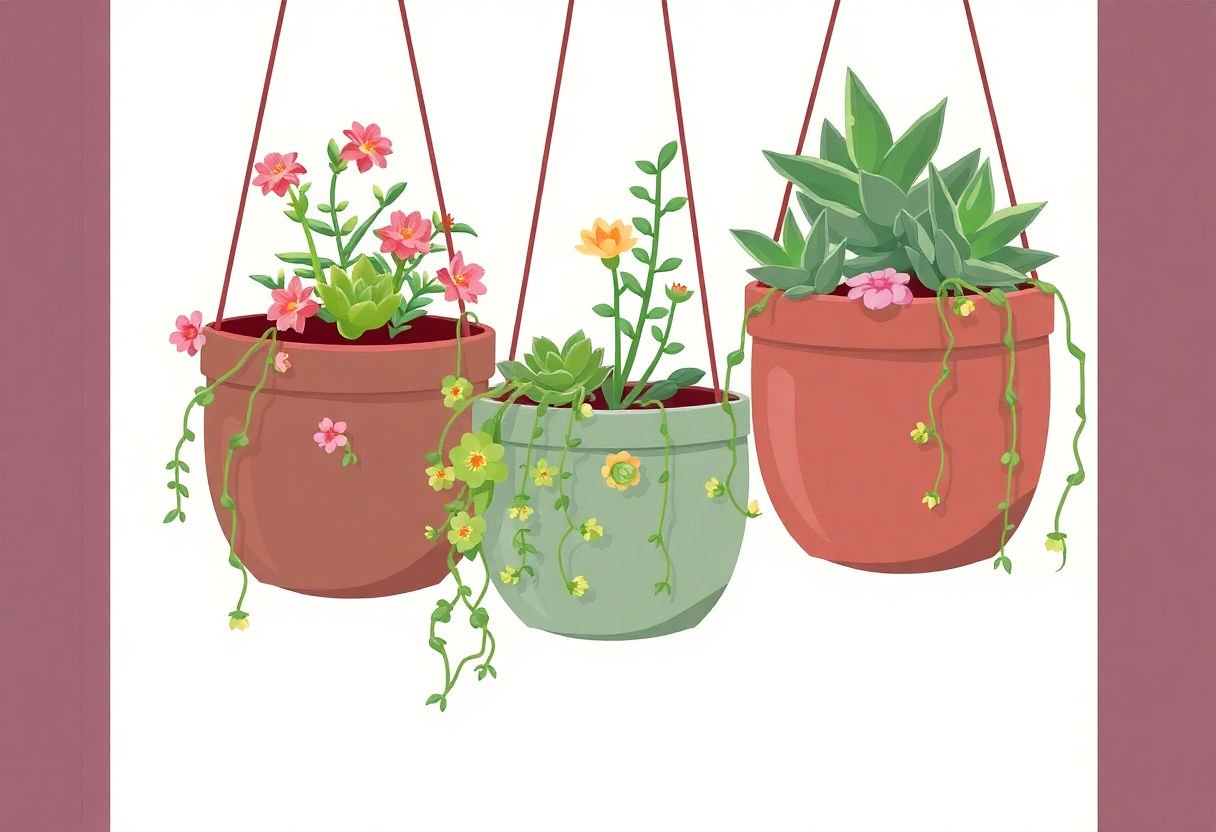
Utilizing hanging displays for flowering succulents is an innovative way to enhance your living space with vibrant greenery. Not only do hanging arrangements provide a dynamic visual element, but they also optimize space—an essential factor in modern interior design.
Creative Solutions for Hanging Displays
Hanging displays can transform ordinary spaces into lush, picturesque settings. Wall-mounted planters offer a sleek, modern look that is perfect for both minimalist and eclectic interiors. These can be arranged in geometric patterns or an organic layout to fit your aesthetic preferences. Alternatively, opt for hanging pots suspended from the ceiling. These allow flowering succulents to cascade beautifully, creating a natural, flowing appearance.
Choosing the Right Location
When deciding where to place your hanging displays, consider areas that can benefit from a touch of nature, such as living rooms, kitchens, or home offices. Ensure that these spaces receive adequate light, as most flowering succulents prefer bright, indirect sunlight. It’s essential to assess the support structure for the hanging fixtures to prevent accidents and ensure plant safety.
Enhancing Interior Design
By selecting pots and containers that complement your current decor, you can seamlessly incorporate succulents into your home design. Choose materials and colors that resonate with your style, whether they are sleek metals for a contemporary vibe or rustic wood for a cozy, natural look.
Hanging displays not only bring a sense of tranquility and beauty into your home but also offer a creative outlet for personal expression, making them a valuable addition to any interior space.
Arranging Succulents on Shelves and Tables
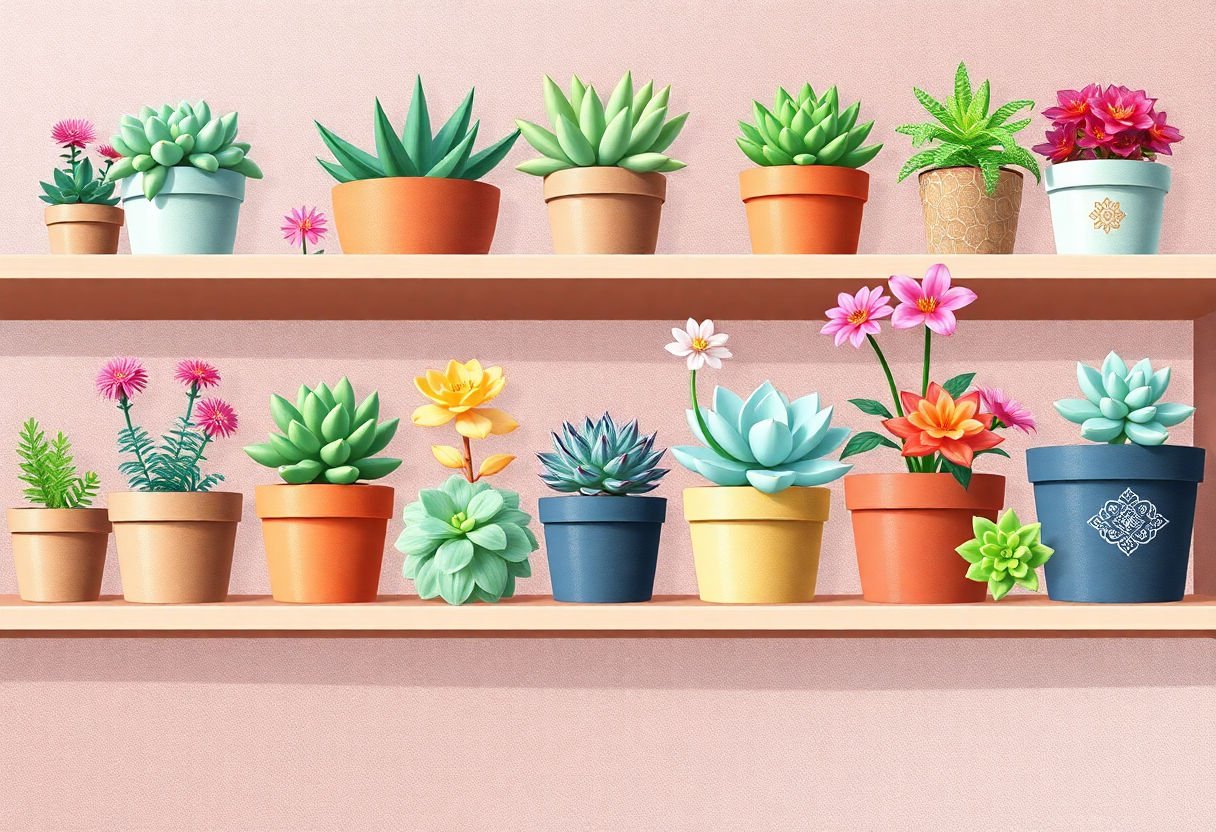
Arranging flowering succulents on shelves and tables is a delightful way to integrate natural beauty into your home decor. These charming plants can transform ordinary spaces into vibrant displays with just a few thoughtful arrangements.
Begin by selecting a variety of succulents with different shapes and sizes to add visual interest. Consider placing them in clusters on your tables or shelving units. This variation not only captivates the eye but also highlights the unique characteristics of each plant. Grouping multiple succulents in decorative pots encourages a lush, garden-like feel even in confined spaces.
For shelves, stagger the succulents at different heights using stands or containers of varied dimensions. By arranging them asymmetrically, you create an engaging focal point that draws attention. When utilizing tables, choose a centerpiece approach with a prominent flowering succulent as the main attraction, surrounded by smaller varieties.
To further enhance the display, mix in natural elements such as stones, driftwood, or moss. These additions complement the succulents while infusing an extra layer of texture and depth. Incorporating decorative elements such as candles or books can also tie in the overall aesthetic of the room.
Ensure adequate light reaches your plants by placing them near windowsills or using LED growth lights, especially in dimly lit areas. A balanced combination of natural and artificial elements not only promotes the well-being of your succulents but also maintains their vibrant blooms.
Arranging these delightful plants with creativity and foresight can effortlessly elevate the ambiance of any room, making your home both welcoming and stylish.
Maintaining Your Flowering Succulent Displays
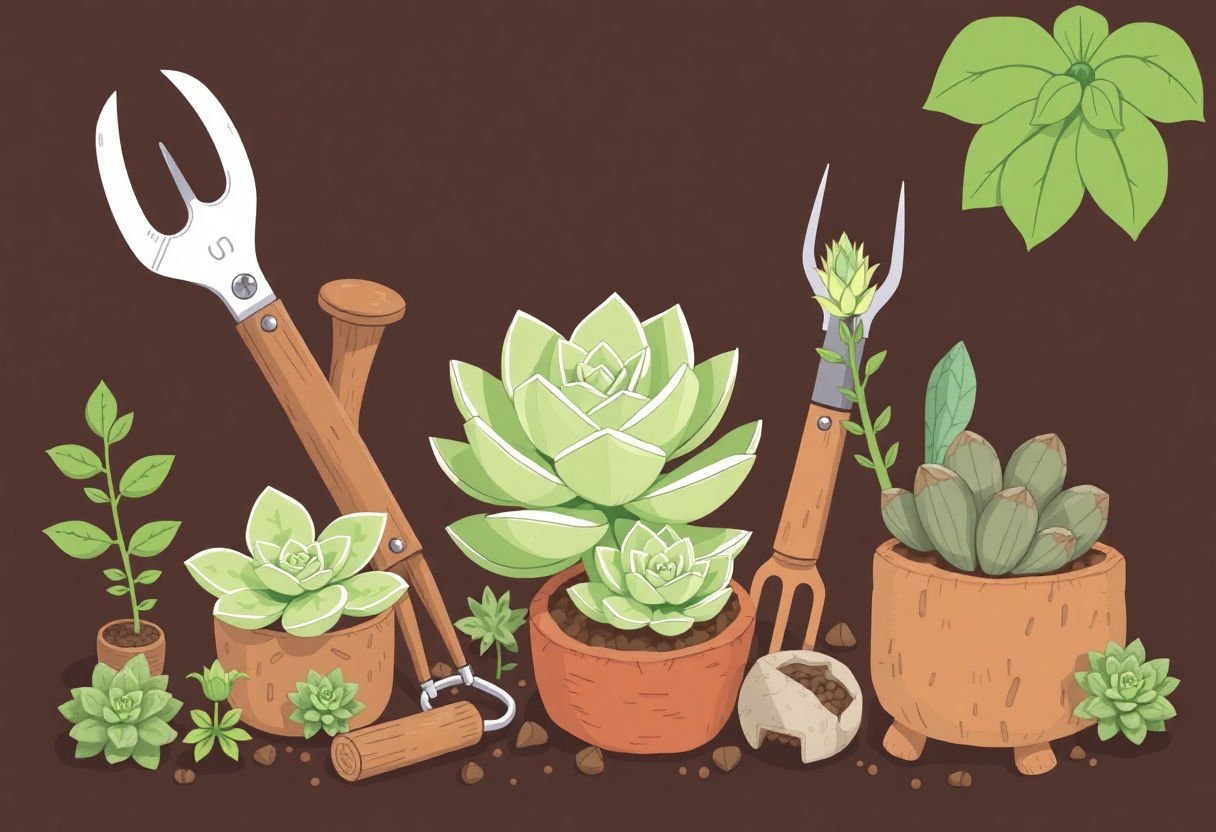
To ensure your flowering succulent displays remain vibrant, it’s critical to adhere to essential care practices. Monitoring both watering and lighting conditions is foundational. Succulents thrive in conditions where their soil can dry completely between waterings. Water sparingly, approximately once every two weeks, adjusting for environmental factors such as humidity and temperature. Overwatering is a primary cause of root rot, which can detract from the aesthetic appeal.
Lighting is crucial. Most flowering succulents prefer bright, indirect sunlight. Position your displays near windows with filtered light, as excessive direct sunlight can scorch the leaves, while insufficient light may inhibit blooming. Consider rotating your displays periodically to ensure even lighting, promoting uniform growth and bloom distribution.
Regular maintenance also involves periodically cleaning the leaves. Dust can accumulate and impede photosynthesis, which is vital for plant health. Gently wipe leaves with a damp cloth to maintain their ability to efficiently convert light into energy.
Additionally, be vigilant for signs of pests such as aphids or mealybugs. These can be removed manually or treated with gentle insecticidal soap as a first line of defense.
Engaging in seasonal fertilization can further enhance the display’s longevity and vigor. Use a balanced, water-soluble fertilizer at half strength during the growing season to support blooming and overall vitality.
By attending to these areas meticulously, your flowering succulent displays will remain a captivating component of your home decor, offering enduring beauty and interest.
Conclusion
Incorporating flowering succulents into your home decor not only enhances aesthetic appeal but also promotes a tranquil, healthy environment with minimal maintenance. This versatile trend allows for creativity in display, be it through vertical gardens, terrariums, or elegant shelf arrangements. As more individuals seek sustainable decor options, flowering succulents offer a unique solution that marries beauty with function. Embrace this opportunity to transform your living space into a vibrant, eco-friendly sanctuary. By experimenting with different display techniques, you can enjoy the beauty and benefits these plants bring to any room in your home.
Frequently Asked Questions
What are the best flowering succulents for indoor display?
The best flowering succulents for indoor display are those that thrive in limited light conditions, such as Kalanchoe, Echeveria, and Haworthia varieties. These plants are renowned for their vibrant blooms and are relatively easy to maintain.
How do I choose the right container for my succulents?
When choosing a container for your succulents, opt for ones with excellent drainage to prevent root rot. Consider containers like terracotta pots, which allow air circulation, or decorative ceramic options that match your interior style.
How often should I water my flowering succulents?
Flowering succulents typically require watering every two to three weeks, depending on the humidity levels and season. Ensure the soil dries out completely between waterings to avoid overwatering, which can lead to root deterioration.
Can flowering succulents thrive in low-light conditions?
While many succulents prefer bright, indirect light, some flowering succulents, like the Peace Lily, can adapt to low-light conditions. However, these plants may exhibit slower growth and fewer blooms in such environments.
How can I maintain the vibrancy of my succulent displays?
To maintain the vibrancy of your succulent displays, ensure they receive adequate light and are not overwatered. Use a balanced fertilizer during the growing season to promote strong growth and flowering, and regularly remove any dead leaves or flowers to keep the plants healthy.
